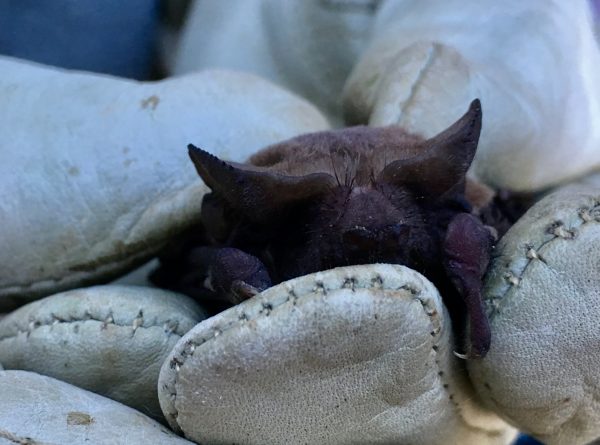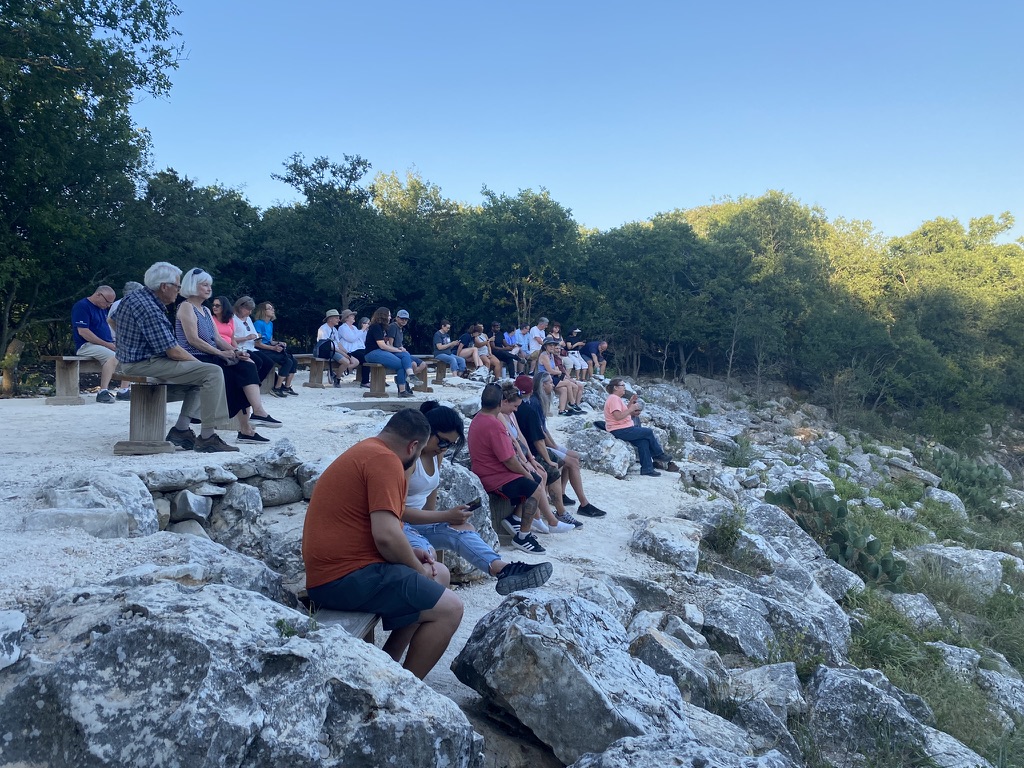After a COVID induced pause, bat lovers can once again partake in a Texas summer ritual: enjoying the natural spectacle of millions of Mexican free-tailed bats emerging from their roosts each evening.
Most bat caves reduced or cancelled their public viewing opportunities in response to the pandemic. The insect-eating night flyers were also unfairly blamed for spreading the deadly virus, making bat viewing less appealing for some. But now that the pandemic is mostly under control, the bat caves are mostly back to their regular schedules.
According to Texas Parks and Wildlife bat biologist Nathan Fuller, Mexican free-tail bats, the species most prevalent in San Antonio and the Texas Hill Country, are thriving.

Mexican free-tailed bat that fell during its flight is rescued by a docent at the Eckert James River bat cave in 2017. –Photo by Monika Maeckle
Fuller said that although at least 50,000 individual bats perished during the extreme freeze of 2021, he feels pretty good about the population.
“With 35 species of bats in Texas, the Mexican free-tail is the bat everyone thinks about, and it appears to be doing pretty well. But all the others are under threat,” said Fuller.
White nose syndrome (WNS), a bat-centric disease caused by a fungus that prefers cool temperatures, continues to plague the nocturnal mammals.
The disease causes a fuzzy white fungus to spread across the bat’s nose and body. The bats get dehydrated because of resulting infection, which rouses them from their hibernative state, known as torpor. This makes them wake up and burn energy, depleting the stored fats that typically get them through the winter. Many don’t make it.
WNS is believed to have been introduced from Europe and has been spreading rapidly since its discovery in New York in 2007.
In 2017, the first cases of WNS were confirmed in North Texas. In 2019, the deadly disease was confirmed at Bracken Cave, the world’s largest known bat colony, about 25 miles north of San Antonio.
Since the Free-tails have such a huge population and generally migrate when the weather turns cold, they are not as vulnerable to WNS as the dozen other bat species that hibernate in Texas each winter.
Several WNS treatments are being explored. Spraying bat cave walls with an antifungal organic compound that decimates the fungus is in development, as are WNS vaccines.
Collisions with wind energy turbines are another leading cause of bat mortality. A German study released this week said that generally 10 bats are killed each year per wind turbine. With more than 70,000 wind turbines in operation in the U.S., that’s a significant dent in the bat population. “If we continue to tolerate this high number of victims at wind turbines, fewer and fewer insect pests will be consumed by bats,” said lead researcher Christian Voigt.
The conservation community is working with wind energy companies to develop solutions, such as ultrasonic deterrents that project loud sounds that scare bats away.
And climate change continues to challenge bats and other wildlife. As the earth warms, the symbiotic relationships that have been in place for millennia–the timing of flowering plants, the emergence of insects–is changing, and not necessarily in ways advantageous to bats that migrate on a schedule mostly dictated by the sun and the seasons.
A 2018 study noted that some of Bracken Cave’s generally migratory bats were overwintering in place and not migrating back to Mexico. Such behavioural changes could have negative implications for the long-term health of the bat population.
More bats remaining here during the winter increases their risk of WNS and creates new vectors. “They can be infected with the pathogen here, then take it all the way to Utah and spread the cold loving fungus, which won’t flourish above 50 degrees,” Fuller explained.

And why should we care about bats?
Each of the flying mammals consumes thousands of insects each evening, which helps keep the ecosystem balanced. Bats help farmers save an estimated $23 billion per year by eating half their body weight in insects. This limits crop damage and reduces the need for costly and harmful insecticides. The Mexican free-tailed bat community in Texas eats millions of corn earworm moths and other crop pests. The Bracken Cave Preserve colony alone is estimated to consume more than 100 tons of these moths every summer night, according to BCI.
Bats also pollinate plants responsible for some of our favorite food and drink. Mangoes, guava, and bananas are all pollinated by bats. Like margaritas? You can thank bats, since they pollinate the agave cactus, the primary ingredient in tequila and mezcal.
Most important, according to Fuller, bats are an indicator species, which means they reflect the general health of the ecosystem. Bats don’t fly in your hair and they’re not scary, he said. “They’re cute, interesting, awesome and can tip off humanity when the ecosystem needs attention, because they’re sensitive to that stuff. They’re these little shrewlike things that lived in the shadows of dinosaurs and became these dominant aerial insectivores of the nighttime sky.”
WANT TO SEE SOME BATS?
San Antonio sits in the heart of the wildlife migratory flyway known as the Texas Funnel. Birds, butterflies, bats and other wildlife move north and south along the IH-35 corridor each year, traveling north from Mexico in the spring, and south in the fall, to take advantage of favorable weather.

Visitors await the bats’ emergence at Bracken cave earlier this week. –Photo by Monika Maeckle
This results in numerous bat roosts in our area, usually in Hill Country caves or urban bridges. According to Texas Parks and Wildlife, nine of the 12 bat viewing sites in the state exist in the Texas Hill Country, most within a two-hour drive of the Alamo City.
Here’s three favorites.
Camden St. Bridge
It’s not as dramatic as Austin’s Congress St. Bridge, but it’s right here in town, a short walk along the river, just south of the Pearl. Parking is sometimes available around Camden and Newell Streets, for a quick stroll down to the bridge.
Each summer, Camden St. hosts a summer batchelor colony of about 50,000 male Mexican free-tailed bats. Each evening, at their whim, the boys emerge from the concrete rafters under IH-35 at Camden St. and plow the skies for insects.
The San Antonio River Authority hosted an annual Bat Loco celebration for several years, but they were discontinued during COVID. According to SARA, no plans exist at the moment to revive the popular bat-centric event.
That said, anyone can mosey on over to the Camden St. Bridge around dusk and wait for the bats to start filing out of the concrete beams supporting the bridge. Typically, emergences occur during spring and summer within 30-40 minutes of sundown.
Bracken Cave Preserve
The best opportunity to view bats nearby occurs at Bracken Cave Preserve, a short drive about 25 miles north of San Antonio. Bat Conservation International oversees the colony, which is the largest known bat colony in the world.
This is a maternal colony of six – 10 million bats. The all-female bat population doubles over the summer as the bat moms drop their pups and increase the size of the colony. The later in the summer you go, the larger and more dramatic the spectacle, since the baby bats join their moms at some point to go insect hunting.
The outing includes a quick overview and Q&A by BCI staff or docents. After the presentation, the group of about 50 moves to mouth of the cave, formerly a sinkhole, where benches and rocks serve as seating. Once the bats start emerging in a vortex known as a “bat-nado” the show is on and continues for hours.
Members of BCI can join for $45 and have access to “member nights” for free at which they can bring three guests. Member nights are scheduled throughout the season.
Nonmembers pay $30 per person. All visits must be booked in advance; no access at the gate. Both member and nonmember nights fill up quickly, so if you want to attend, book early.
Eckert James River Bat Cave
If you’re up for a more adventurous outing, consider a visit to the Eckert James River Bat Cave outside Mason, Texas. About a two-hour drive from San Antonio, the cave is operated by the Nature Conservancy of Texas and will be open for the first time in two years on “most Fridays and Saturdays” June 10 – August 27. The Nature Conservancy encourages calls to 325-347-5970 to confirm that the cave will be open, pending weather or other possible complications.
This maternal colony bloats from two to four million bats over the summer as the babies get big enough to fly.
The cave is not wheelchair accessible, entails an exciting low water crossing for your vehicle (no worries, it’s totally safe), and requires a short hike up a trail. There, a small outdoor seating area allows for an up-close view, as a trained docent offers a tutorial on the bats and their life cycle.
This ranks among the most intimate bat-watching experiences, as visitors perch on the rim of the cave as the bats emerge at dusk, swirling in their “bat-nado” as they climb into the skies for insect feeding.
For a complete list of bat caves open to the public, check out the Texas Parks and Wildlife Bat-Watching Sites Guide.


Leave A Comment